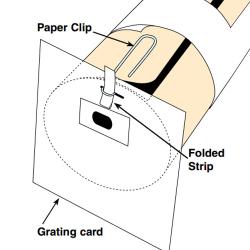Source Institutions
Source Institutions
Add to list Go to activity
Activity link broken? See if it's at the internet archive

In this activity, learners construct their own spectroscope as they explore and observe spectra from familiar light sources. Learners can be challenged to make technological improvements to their spectroscopes and/or participate in extension activities that expand their understanding of different kinds of spectra and sharpen their observing skills.
- 30 to 45 minutes
- 45 to 60 minutes
- $5 - $10 per group of students
- Ages 14 - 18
- Activity, Lesson/Lesson Plan
- English
Quick Guide
Materials List (per group of students)
- Incandescent light bulb (60-100-watt frosted) and base
- String of clear holiday lights (optional)
- Fluorescent light (single bulb)
- Transmission grating sheet (available from science supply store)
- 2 transparency sheets
- Glo-Doodler (available from Colorforms) (optional)
- Manila folders (halves)
- Black paper
- Index cards (3x5-inch size)
- Tape or rubber bands
- Scissors
- Small paper clips
- Hole punchers
Subjects
-
Earth and Space Science
- Astronomy
-
Solar System
- The Sun
-
Physical Sciences
-
Light and Optics
- Electromagnetic Spectrum
- Sunlight and Color
-
Vibration and Waves
- Diffraction and Interference
-
Light and Optics
-
Engineering and Technology
-
Technology
- Information and Communication
-
Technology
-
The Nature of Science
-
The Scientific Process
- Conducting Investigations
-
The Scientific Process
Audience
To use this activity, learners need to:
- see
- see color
- touch
Learning styles supported:
- Involves hands-on or lab activities
Other
Includes alignment to state and/or national standards:
This resource is part of:
Access Rights:
- Free access
By:
- Education and Outreach Office, McDonald Observatory
Rights:
- All rights reserved, The University of Texas at Austin, 2008
Funding Source:
- NASA (Space Telescope Science Institute, operated by the Association of Universities for Research in Astronomy), HST-EO-10861.35-A
